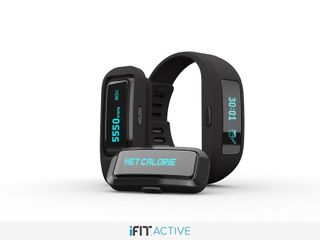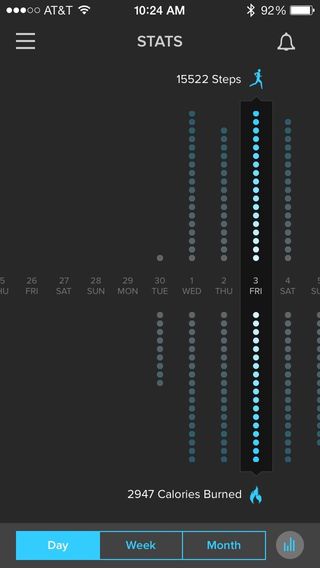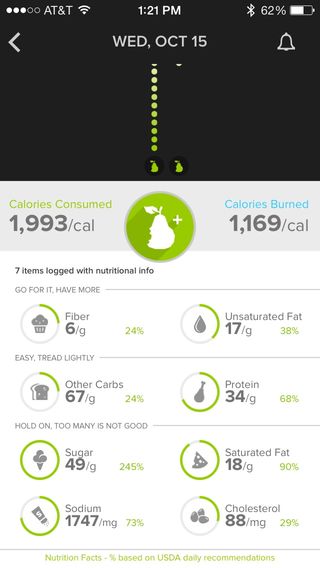iFit Active: Fitness Tracker Review

The iFit Active is a fitness tracker that aims to measure your exercise, diet and sleep. The device is an extension to the iFit platform, which includes a website where users can create a profile and then track their activity and share their workouts with friends. Unlike most fitness trackers, the iFit can track the exercise you do on a treadmill, as long as you use one of the compatible machines (including ProForm, FreeMotion and Nordic Track brands).
I tested the iFit for about a week, and by the end of it I felt informed about my movement patterns and calorie consumption. The device costs $129, and is simple, comfortable and useful. But it doesn't include all the features that I'd like to find in a fitness tracker — it doesn't have a heart-rate sensor and, although resistant to sweat and splashes, it isn't waterproof. Here's a breakdown of how the iFit performed in several areas. [Best Fitness Tracker]
Overall Rating: 5.8/10
The pros of the iFit Active compared with other fitness trackers include that it syncs wirelessly with your phone, your daily progress is visible on the band's screen itself, and that it complements your Web-based account on iFit. For people who are already using the iFit compatible treadmill at their house or gym, the iFit Active has the extra benefit of being on the same platform.
The cons of the device include not having a heart-rate sensor, and bugs in the app when using the barcode scanning feature. The device also is not waterproof so can't be worn while swimming.
Design/Comfort: 6/10

In contrast to many trackers, which can be worn only on the wrist, the iFit can be worn as a wristband, or clipped to your clothes or simply carried in your pocket. I wore it on my wrist. It was difficult to fasten and unfasten the band, but once the device was on my wrist, it felt lightweight and comfortable. The device has an LED screen where you can see your data, such as steps taken that day, the percentage of your daily goal covered, calories you have consumed and calories you have burned.
The device syncs wirelessly with the iFit Track app on your phone as well as with your profile on iFit.com, so it is a lot easier to review your stats on the phone, compared with trackers that have to be manually connected to sync with their apps. The rubbery band of the device on the wrist comes in four colors, blue, black, red and white. It's not the most fashionable wristband I've seen, but it also isn't ugly and keeps a low profile.
Sign up for the Live Science daily newsletter now
Get the world’s most fascinating discoveries delivered straight to your inbox.
The device is charged using a cable, and lasts about five days on a full charge.
User-Friendliness: 6/10
The iFit Active is pretty much ready to go out of the box. The mobile app is extremely simple and intuitive. But navigating the website can be a little bit trickier the first time around. Still, I managed to figure out how everything works on the device, the app and the website on the first day of using it.
On the website you can find workout programs, or create your own programs (such as a running route) and share them with others. You can log in your workout, and the mobile app and the tracker device will automatically get updated too.
Value of Information: 5/10
The iFit Active captures the data that most standard fitness trackers do. It tracks your daily steps and shows how far you are from your goal (usually 10,000 steps), lets you input what you ate, calculates how many calories you have burned, and tracks your sleep.

Like many other trackers, the iFit lets you set goals, for example, calorie-intake goals to lose weight. You can also change your goal for the number of steps taken daily. You can monitor your adherence to these goals and your progress toward your goals. The device vibrates when you achieve your goals.
The iFit's step count was fairly consistent with other trackers I have tested. For example, iFit and other trackers I have tested all say that I take about 1,800 to 2,000 steps to get from the subway station to my office every morning.

You can manually log the food you ate, and the app will calculate your caloric intake. The app also allows you to scan the barcode on food products to input nutritional information, but about half the times I tried to do this, the app crashed and I had to start all over. Once you manage to get the data on the food you ate stored (either manually or by using the barcode feature), the app shows how much you've consumed in each nutritional category, including fiber, saturated and unsaturated fat, sugar, protein, cholesterol and salt.
The app also shows you how many calories you've burned by moving around or when your body is at rest (sitting still or lying in bed).
For sleep tracking, the device records how much sleep you get each night, and aims to track the quality of your sleep by measuring the amount that was spent in "deep" and "light" sleep. But similar to the sleep-tracking features of other fitness trackers, your sleep patterns are interpreted from your movements during sleep, which may not reflect the exact quality and quantity of sleep.
You can connect your Facebook or Google Plus profiles to your iFit profile, and if your friends use iFit, you can share your progress or chat with them too.
One feature that the iFit Active lacked was a heart-rate monitor, something that is useful if you are a runner or just interested in learning more about your cardiac fitness.
Enjoyment/Inspiration: 6/10
The iFit Active was informative and motivating. As with other trackers, the iFit made me more aware of my habits and daily patterns, and pushed me to improve on them. Its feature of letting you find new workout programs on the website and feeling part of a community was another motivating factor in using the iFit that not all trackers have.

